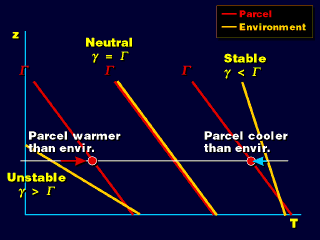 Graphical representations of the relationship between environmental lapse
rate and the adiabatic lapse rate, and atmospheric stability. Note how the difference
in the lapse rates shows up as different slopes for the T(z) plots.
Graphical representations of the relationship between environmental lapse
rate and the adiabatic lapse rate, and atmospheric stability. Note how the difference
in the lapse rates shows up as different slopes for the T(z) plots.A temperature plot straight up and down means the temperature is the same at every altitude; thus, the (environmental) lapse rate is zero. If the temperature decreases with increasing altitude, we have a positive lapse rate; the more this temperature plot leans to the left, the larger the lapse rate (note that the slope of the line is correlated to lapse rate). If the temperature increases with increasing altitude, the plot leans to the right. These right-leaning plots represent negative lapse rates; the more rightward the lean, the smaller or more negative the lapse rate.
All air parcels moving adiabatically lose 10°C of temperature for
every km they rise. We will plot the temperature variation inside these
parcels with red lines called adiabats. All of these adiabats will
have the same slope because the lapse rate associated with them are all
the same.
 Graphical representations of the relationship between environmental lapse
rate and the adiabatic lapse rate, and atmospheric stability. Note how the difference
in the lapse rates shows up as different slopes for the T(z) plots.
Graphical representations of the relationship between environmental lapse
rate and the adiabatic lapse rate, and atmospheric stability. Note how the difference
in the lapse rates shows up as different slopes for the T(z) plots.
The point where the lines cross is the initial position for the air parcel, since it needs to be in equilibrium (hence, parcel temperature = environmental temperature). As the air parcel is lifted dry adiabatically, its temperature varies along the red line (representing a loss of 10°C per km of ascent). The environmental temperature (the temp. outside the parcel), meanwhile, changes according to the gold line.
In the stable case, the environmental temperature decreases less rapidly than the parcel temperature (that's what gamma < Gamma means) so the air parcel is cooler than its environment after the nudge upwards. The now-negatively buoyant parcel then sinks back down to its original position. So the upward nudge is restored or resisted in this atmospheric case.
In the unstable case, the parcel loses temperature less rapidly than the environment, so the upward nudge makes the parcel warmer than its environment. The positively buoyant parcel continues to rise on its own. A slight nudge of the parcel has now resulted in a larger motion with no more external interference.
In the neutral case, the parcel and the environment lose temperature
at the same rate, so the parcel and environmental temperature are always
the same. The nudged parcel is in equilibrium wherever it is moved (vertically),
so it stays where it's moved. Atmospheric turbulence can move parcels up
and down in this atmosphere, and they will not try to go back to where they
came from or continue to move away.